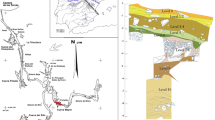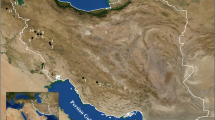Abstract
The animal remains found at the fourteenth–fifteenth century Hof van Leugenhaeghe are crucial to reconstruct the life of the noble inhabitants, as all buildings were destroyed with the construction of a later estate on the property called the Blauwhof. The diet confirms the high social status of this nobility with the suspected consumption of pig skulls, a possible sign of wealth in late-medieval Flanders. Other signs of a noble diet are found as well: juvenile cattle, a diverse spectrum of game, partridge and grey heron. The observed pattern of a wealthy diet is consistent with the zooarchaeological assemblages found at other noble sites in late-medieval Flanders.








Similar content being viewed by others
References
Albarella U, Davis SJ (1994) Medieval and post-medieval mammal and bird bones from Launceston Castle, Cornwall: 1961–1982. Excavations. English Heritage
Albarella U, Thomas R (2002) They dined on crane: bird consumption, wild fowling and status in medieval England. Acta Zoologica Cracov 45:23–38
Aluwé KLM, Starkovich B, Van Vaerenbergh J (2015) The diet of the Portuguese merchant family Ximenez at the “Blauwhof” (Belgium): between tradition and display in the 16th–17th centuries. J Archaeol Sci Rep 3:581–590
Ashby SP (2002) The role of zooarchaeology in the interpretation of socioeconomic status: a discussion with reference to medieval Europe archaeological. Rev Camb 18:37–59
Binford LR (1978) Dimensional analysis of behavior and site structure: learning from an Eskimo hunting stand. Am Antiq 43:330–361
Boessneck J (1969) Osteological differences between sheep (Ovis aries Linné) and goat (Capra hircus Linné). In: Brothwell D, Higg E (eds) Science in archaeology, London: 331–58
Buylaert F, De Clercq W, Dumolyn J (2011) Sumptuary legislation, material culture and the semiotics of ‘vivre noblement’ in the county of Flanders (14th–16th centuries). Soc Hist 36:393–417
De Jong T (1992) Huisdieren, jachtwild, vissen en weekdieren: een weerspiegeling van gevarieerde maaltijden. In: Arts N (ed) Het Kasteel van Eindhoven. Archeologie, ecologie en geschiedenis van een heerlijke woning:1420–1676, Eindhoven:214–236
DeFrance SD (2009) Zooarchaeology in complex societies: political economy, status, and ideology. J Archaeol Res 17:105–168
De Wilde M, Ervynck A, Van Neer W, De Meulemeester J, Van Der Plaetsen P (1994) De'Burcht'te Londerzeel vol 1. Archeologie in Vlaanderen, Monografie.
Dupré S (2011) Trading luxury glass, picturing collections and consuming objects of knowledge in early senventeenth-century Antwerp. In: Dupré S, Lüthy C. (eds) Silent messengers: the circulation of material objects of knowledge in the Early Modern Low Countries. LIT Verlag, Berlin [u.a.]: 261–291
Ervynck A (2003) De introductie van het konijn in de Lage Landen: een verkeerde datering voor vondsten uit een latrine bij de abtswoning van de Sint-Salvatorsabdij te Ename (stad Oudenaarde, prov. Oost-Vlaanderen). Archeol Vlaanderen 7:111–114
Ervynck A, Lentacker A (2008) 9.3 Archeozoölogisch onderzoek. Onroerend erfgoed. https://onderzoeksbalans.onroerenderfgoed.be/node/21292. Accessed 5 March 2016
Ervynck A, Van Damme D (1988) Archeozoölogisch onderzoek op het Kasteel van Laarne; hoezo? Castellum 5:10–17
Ervynck A, Van Neer W, Van der Plaetsen P (1994) Dierlijke resten. In: De Wilde M, Ervynck A, Van Neer W, De Meulemeester J, Van Der Plaetsen P De ‘Burcht’ te Londerzeel, Archeologie in Vlaanderen vol. 1, Monografie, Zellik 99–170
Ervynck A, Van Neer W, Hüster-Plogmann H, Schibler J (2003) Beyond affluence: the zooarchaeology of luxury. World Archaeol 34:428–441
Ervynck A, Lentacker A, Van Neer W (2006) Mens en dier in de 12de eeuw. In: De Decker S (ed) Het kasteel van Assenede. Van opgraving tot historisch landschap. Mens & Cultuur uitgevers, Gent 45–56
Gautier A (1981) Vertebratenresten van de mote te Drongen (einde 14de-begin 15de eeuw). Stadsarcheologie Bodem Monument Gent 5:2–4
Gautier A, Rubberechts V (1978) Animal remains of the Senecaberg fortification. Bull Musées R Art Hist 48:51–84
Goddeeris B, De Smet G, Roggeman W (2002) Some gastronomic aspects of bird species in still life paintings of Frans Snyders (Antwerp, 1579–1657). Rev Belge Philologie Hist 80:1431–1448
Grant A (1982) The use of tooth wear as a guide to the age of domestic ungulates. In: Wilson B (ed) Ageing and sexing animal bones from archaeological sites. SBAR 109:91–108
Groot M (2010) Handboek zoöarcheologie. Archeologisch Centrum van de Vrije Universiteit, Hendrik Brunsting Stichting (ACVU-HBS)
Habermehl K-H (1975) Altersbestimmung bei Haus-und Labortieren. Paul Parey, Berlin
Klein RG, Cruz-Uribe K (1984) The analysis of animal bones from archeological sites. University of Chicago Press
Kretschmar FGLOV (1978) Towards the identification of a drawing of a Flemish château. Master Drawings 16:45–106
Lentacker A (1984) Beenderresten uit Mestput I in het Dobbelslot te Gent (eind 14de-15de eeuw). Stadsarcheologie Bodem Monument Gent 8:10–12
Lyman RL (1994) Vertebrate taphonomy. Cambridge University Press
Maenhaut Van Lemberge V (1985) De Warandemotte te Veurne: site catchment en voornaamste grote huisdieren (varken, rund). Universiteit Gent, student thesis
Moens J, Ameels V, De Groote K (2011) Archeologisch noodonderzoek naar het voormalige Hof van Peene in Baasrode (prov. Oost-Vl.). Relicta, Archeologie. Monumenten-en Landschapsonderzoek Vlaanderen 8:47–82
Moran N, O’Connor T (1994) Age attribution in domestic sheep by skeletal and dental maturation: a pilot study of available sources. Int J Osteoarchaeol 4:267–285
Müldner G, Britton K, Ervynck A (2014) Inferring animal husbandry strategies in coastal zones through stable isotope analysis: new evidence from the Flemish coastal plain (Belgium, 1st–15th century AD). J Archaeol Sci 41:322–332
Pohl H (1977) Die Portugiesen in Antwerpen (1567–1648). Hochschulschrift, Steiner
Reitz EJ, Wing ES (2008) Zooarchaeology. Cambridge University Press, Cambridge
Schmid E, Garraux O (1972) Atlas of animal bones. Elsevier Amsterdam
Silver IA (1969) The ageing of domestic animals. In: Brothwell D, Higg E (eds) Science in archaeology. London 283:302
Stiner MC (1991) Food procurement and transport by human and non-human predators. J Archaeol Sci 18:455–482
Stiner MC (2002) On in situ attrition and vertebrate body part profiles. J Archaeol Sci 29:979–991
Stiner MC (2005) The faunas of Hayonim Cave, Israel: a 200,000-year record of paleolithic diet, demography, and society. American School of Prehistoric Research Bulletins, vol 48. Harvard University Press
Van der Veen M (2003) When is food a luxury? World Archaeol 34:405–427
Van Vaerenbergh J, Van Roeyen J-P (2007) Steendorp-Blauwhof. Ann K Oudheidkundige Kring Het Land Waas 110:430–446
von den Driesch A (1976) A guide to the measurement of animal bones from archaeological sites: as developed by the Institut für Palaeoanatomie, Domestikationsforschung und Geschichte der Tiermedizin of the University of Munich. vol 1. Peabody Museum Press
Weaver TD, Boyko RH, Steele TE (2011) Cross-platform program for likelihood-based statistical comparisons of mortality profiles on a triangular graph. J Archaeol Sci 38:2420–2423
Acknowledgments
We would like to thank the Archeologische Dienst Waasland, for giving the opportunity to study this zooarchaeological assemblage. We would also like to thank Prof. Dr. Nicholas Conard and Prof. Dr. Jörn Staecker for comments on earlier versions of this work and the University of Tübingen for the support and access to the reference collection.
Author information
Authors and Affiliations
Corresponding author
Rights and permissions
About this article
Cite this article
Aluwé, K.L.M., Starkovich, B.M. & Van Vaerenbergh, J. A noble diet at the Hof van Leugenhaeghe (Steendorp, Belgium): pig skulls as a fourteenth–fifteenth century delicacy?. Archaeol Anthropol Sci 10, 247–257 (2018). https://doi.org/10.1007/s12520-016-0349-5
Received:
Accepted:
Published:
Issue Date:
DOI: https://doi.org/10.1007/s12520-016-0349-5




